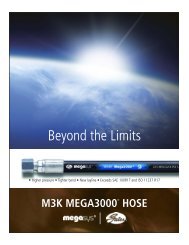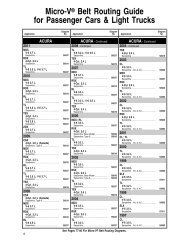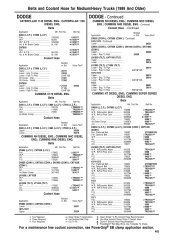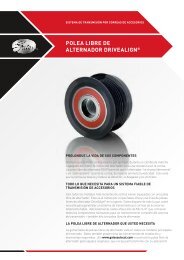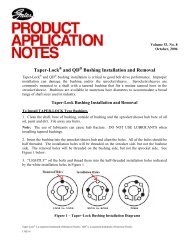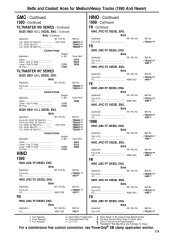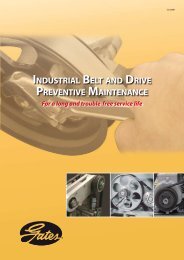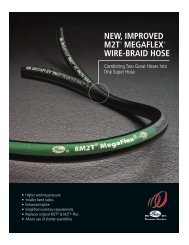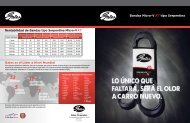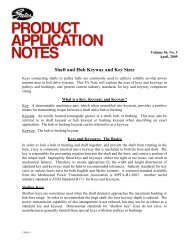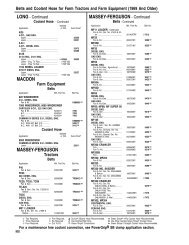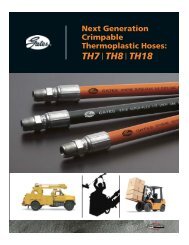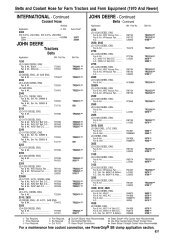PowerGrip® GT® Belt Drives
PowerGrip® GT® Belt Drives
PowerGrip® GT® Belt Drives
Create successful ePaper yourself
Turn your PDF publications into a flip-book with our unique Google optimized e-Paper software.
Synchronous <strong>Belt</strong> <strong>Drives</strong> – Sprocket Specifications<br />
Sprocket Specifications — continued<br />
C. Groove Specifications<br />
Accurate reproduction of the correct sprocket groove<br />
profile in production sprockets is essential in<br />
obtaining the full performance capabilities of the<br />
drive system. The correct groove profile for a<br />
sprocket changes as the number of grooves<br />
changes. Gates can assist the designer with<br />
sprocket groove profile data. Data can be furnished<br />
in the following forms:<br />
Master Profile: A scaled line drawing of the<br />
ideal groove profile with tolerance bands<br />
plotted on dimensionally stable translucent<br />
material. Suitable for groove inspection<br />
purposes on an optical comparitor.<br />
Dimensioned Profile Drawing: A line<br />
drawing of the ideal groove profile with all arcs<br />
and radii defined. Suitable for mold design.<br />
Digitized Points: A series of X and Y<br />
coordinates defining the ideal groove profile.<br />
Available in printed form or on a floppy disk.<br />
Suitable for mold design.<br />
Some sprocket groove profile data is<br />
proprietary and can be furnished only to Gates<br />
licensees. Check with Gates Application<br />
Engineering for availability.<br />
Tolerancing/Inspection Procedure: A typical<br />
sprocket groove tolerance band is illustrated in Fig.<br />
11. Groove inspections must by made on an optical<br />
comparitor at a specified magnification. The actual<br />
sprocket groove profile must fit within the specified<br />
tolerance bands without any sharp transitions or<br />
under cuts.<br />
Figure 11<br />
D. Flange Design and Face Width<br />
Guidelines<br />
Flanging Guidelines<br />
Face Width Guidelines<br />
Table 23<br />
Nominal Flange Dimensions for Molding,<br />
Sintering, Casting, etc.<br />
Minimum Nominal<br />
<strong>Belt</strong> Flange Height Flange Height<br />
Section (in) (mm) (in) (mm)<br />
MXL 0.040 – 0.050 –<br />
XL 0.060 – 0.080 –<br />
2MR 0.043 1.10 0.059 1.50<br />
3M&3MR 0.067 1.70 0.098 2.50<br />
5M&5MR 0.091 2.30 0.150 3.80<br />
Table 24<br />
Additional amount of Face Width recommended<br />
over Nominal <strong>Belt</strong> Width (Add Table Values to<br />
Nominal <strong>Belt</strong> Width for Nominal Face Width)<br />
Nominal Face Width Nominal Face Width<br />
<strong>Belt</strong> Unflanged Flanged<br />
Section (in) (mm) (in) (mm)<br />
MXL +0.125 – +0.040 –<br />
XL +0.190 – +0.060 –<br />
2MR +0.118 +3.00 +0.039 +1.00<br />
3M&3MR +0.157 +4.00 +0.049 +1.25<br />
5M&5MR +0.197 +5.00 +0.059 +1.50<br />
64 The World’s Most Trusted Name in <strong>Belt</strong>s, Hose & Hydraulics.



